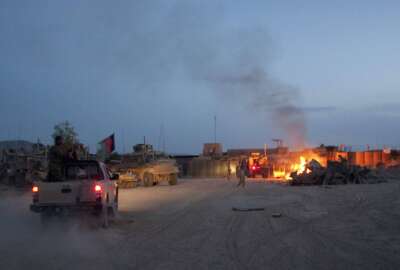
Veterans and their supports push for burn pit related relief
Burn pits, they're the agent orange of the most recent generation of veterans. Veterans who were exposed to the open junk incinerators in Iraq and Afghanistan have...
Best listening experience is on Chrome, Firefox or Safari. Subscribe to Federal Drive’s daily audio interviews on Apple Podcasts or PodcastOne.
Burn pits, they’re the agent orange of the most recent generation of veterans. Veterans who were exposed to the open junk incinerators in Iraq and Afghanistan have long complained of resulting health maladies. President Joe Biden mentioned it in his state of the union speech. Some VA benefits have begun to trickle out. For an update, the Federal Drive with Tom Temin spoke to the co-founder and special counsel of the National Veterans Legal Services Program, Bart Stichman.
Interview transcript:
Tom Temin: Bart, good to have you back.
Bart Stichman: Thanks, Tom.
Tom Temin: What is the status of burn pits? I mean, it took decades for Agent Orange to be an assumed problem for those that were near it and tell us the status of burn pit benefits.
Bart Stichman: Well, it’s Congress and the VA and the executive department have moved a little faster than in the Agent Orange sphere. And a bill is passed the house already, another one is similar pending in the Senate. And then you have the recent speech by the president, that you just referred to, where he is also urging the VA itself to unilaterally add diseases, recognize them as related to exposure to burn pits, and/or Congress pass these bills that are pending, send it to my desk. And if any of that happens, a lot of additional diseases are going to be recognized as related to burn pits, which means if you apply to the VA for disability benefits for one of the listed diseases, and you served in southwest Asia, then you’ll be entitled to disability benefits for those diseases.
Tom Temin: And does this cover I guess, as I said in the opening, both Afghanistan in Iraq, they used burn pits?
Bart Stichman: Absolutely. Both those, Djibouti, any area in southwest Asia.
Tom Temin: And what are the diseases? And is it possible to distinguish them from similar types of maladies? I guess these are respiratory, that might have been from people that maybe smoked 100 cigars a day or something?
Bart Stichman: Well, in the House bill, which has the longest list of diseases to make presumptively service-connected. Let me read some of them. A lot of cancers, any respiratory, gastrointestinal, reproductive cancer, lymphoma cancer, kidney, brain, melanoma, pancreatic cancer, those are the cancers. And then there’s respiratory diseases like chronic bronchitis, etc. And it’s true that smoking can cause some of those cancers. But that’s been true for Agent Orange as well, lung cancer is a disease listed is related to Agent Orange and people who may have smoked, it’s difficult to tell what was the causative agent, but the rules of the game are you get VA benefits, the benefit of the doubt for those diseases.
Tom Temin: And talk about briefly the benefits themselves. Is it simply compensation? Is it considered disability payments? Or what is the program? And what are the benefits specifically?
Bart Stichman: Well, let’s talk about health care and financial benefits. For health care, the bills pending in Congress, regardless of the type of disease you have, it doesn’t even have to be a listed disease, extend the five year period from your service in southwest Asia to a much longer period of time that you’re entitled to free VA health care. So that’s true of these bills, regardless of the disease you have. If it’s one of the listed diseases, and you apply to the VA, you’d get financial benefits, service connected disability compensation, which depends on your degree of disability how much money it is, but if you’re totally disabled due to your cancer, or other disease, then you’d be getting close to $38,000 a year in tax-free disability compensation.
Tom Temin: We’re speaking with Bart Stichman. He’s co-founder and special counsel at the National Veterans Legal Services Program. And since this is the Legal Services Program, and you have been a friend of the court and several lawsuits, have launched lawsuits over the years to get VA to shake loose on a number of issues, are there any lawsuits going on now about burn pits?
Bart Stichman: No, not much in that area. We have a burn pits class assistance program that we opened up last year, where we’re representing individuals who have claims for some of these diseases on an individual basis we apply on their behalf. These potential additions of diseases are not currently applicable to their claims, the bills have to be passed. The VA has to change their rules. In the meantime, we’re representing them on a case-by-case basis at this point. In which case, you have to get medical evidence of a connection between your exposure to burn pits and your current disease. So we have to get a medical expert, often paying for them in order to win the claim.
Tom Temin: And what about the service itself? I mean, you could have been walking by a burn pit once, or you could have been tending a burn pit for a period of a month or something. I mean, there’s exposure and there’s exposure, is there any element of degree there that is part of this?
Bart Stichman: No, none of the bills make the distinction you’re talking abou. It would be very difficult to figure out person by person what the amount of fumes and smoke that you were exposed to, it’d be an administrative nightmare to do that on a case-by-case basis. And so these bills wisely, I believe, say if you served in the area, that’s enough to be presumed exposed.
Tom Temin: And in the cases for which VA is now paying burn pit benefits, what are their criteria, as they stand before these laws are passed?
Bart Stichman: You’re right, the VA has last year added the first diseases, three diseases, sinusitis, rhinitis and asthma. If you apply and you served in the area, doesn’t matter number of days, you win. But they’ve added another requirement, you had to have suffered from one of those three diseases within 10 years of your discharge. So the philosophy behind that, which I don’t personally agree with, is that if it took you more than 10 years to come down with your asthma or other condition, then it’s probably not due to the burn pets. So those are the rules currently.
Tom Temin: It makes you wonder what, if any, is the research and scientific basis for any of this?
Bart Stichman: There’s a decent amount of science out there, which is why these bills name all these diseases. And I’ll tell you partially why there’s science out there. DoD did an analysis, did air samples of the burn pits while they were operating about 10 years ago, and they found all kinds of toxic substances, benzene, dioxin, the contaminant in Agent Orange, and other particulate matter that’s toxic. And we know individually what these toxic chemicals cause. And so there’s a basis to create a list of what’s related.
Tom Temin: So then at this point, Congress is it so to speak in this great game here of getting this whole issue resolved?
Bart Stichman: Yeah, there’s really three playing fields, four: the house, the senate, the VA has the right, and they’ve already exercised it to add a rule, making it easier for veterans to win their burn pit related cases by saying this disease is connected. And the president can so called order the VA to do it as well.
Tom Temin: And to be clear, the House has passed that bill. So really, it’s the Senate at this point.
Bart Stichman: Yes, the House has passed the bill. The Senate has a pending bill that’s very closely related to the House bill. So if the Senate passed its own bill, and it’s slightly different, there’d have to be a conference. But it should be an easy conference since they’re very similar.
Tom Temin: Bart Stichman is co-founder and special counsel of the National Veterans Legal Services Program. As always, thanks so much.
Bart Stichman: You’re welcome, Tom. Good to be back with you.
Copyright © 2025 Federal News Network. All rights reserved. This website is not intended for users located within the European Economic Area.
Tom Temin is host of the Federal Drive and has been providing insight on federal technology and management issues for more than 30 years.
Follow @tteminWFED





